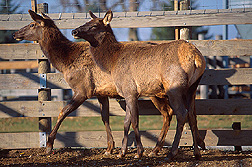This page has been archived and is being provided for reference purposes only. The page is no longer being updated, and therefore, links on the page may be invalid.
|
Read the magazine story to find out more. |
|
|
HOOF-Prints Help Find Where Outbreaks Begin
By Luis PonsJanuary 20, 2006
Locating potential sources of brucellosis outbreaks is easier now, thanks to a new DNA fingerprinting technique developed by scientists with the Agricultural Research Service (ARS) and the Animal and Plant Health Inspection Service (APHIS).
Finding the source of these outbreaks helps with identification and isolation of infected animals, and with telling whether the outbreaks started in wildlife, according to microbiologists Betsy Bricker at ARS' National Animal Disease Center and Darla Ewalt of APHIS' National Veterinary Services Laboratories, both in Ames, Iowa.
The new technique—called "HOOF-Prints," for Hypervariable Octameric Oligonucleotide Fingerprints—allows scientists to identify strains of brucellosis through differences in their DNA sequences, and to separate these strains into subtypes.
Brucellosis is an extremely infectious disease caused by Brucella bacteria that induce abortions in many animals, including sheep, goats, cattle, pigs, elk and bison. Humans who come in contact with Brucella can get undulant fever, which is marked by chronic flulike symptoms.
Though almost eradicated from the United States, brucellosis can still prove costly to livestock producers through testing and losses. Outbreaks may cause states to lose brucellosis-free status, meaning their cattle must undergo extensive testing before they can be shipped away.
The new method uses polymerase chain reaction (PCR) technology, which copies large amounts of DNA molecules from small amounts of source DNA. According to Ewalt, the HOOF-Prints technique is intended to complement existing PCR and bacteriological tests used to identify Brucella species.
HOOF-Prints was first applied in the field in 2002 when it was used to trace a brucellosis outbreak in Fremont County, Idaho, cattle to local elk. It could eventually be applied toward generating an international database of Brucella fingerprints that would be used to control the disease, according to Bricker.
Read more about the research in the January 2006 issue of Agricultural Research magazine.
ARS and APHIS are part of the U.S. Department of Agriculture. ARS is USDA's chief scientific research agency, while APHIS protects and promotes the nation's agricultural health.

